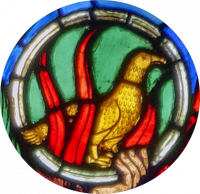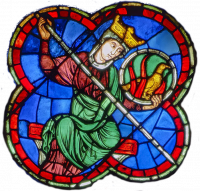Table of Contents
Welcome to the home of EVAA
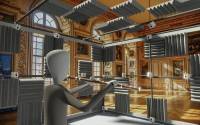 EVAA (Experimental Virtual Archaeological-Acoustics) is a directive/umbrella project centralizing a variety projects focusing on heritage acoustics research and the use of acoustic simulations and virtual reality as part of the Past Has Ears. Our goals are to facilite and coordinate research in this area, and encouraging collaborations and communications between researchers in various field interested in acoustic cultural heritage.
EVAA (Experimental Virtual Archaeological-Acoustics) is a directive/umbrella project centralizing a variety projects focusing on heritage acoustics research and the use of acoustic simulations and virtual reality as part of the Past Has Ears. Our goals are to facilite and coordinate research in this area, and encouraging collaborations and communications between researchers in various field interested in acoustic cultural heritage.
EVAA is coordinated under the Sound Spaces working group, of the group Lutheries - Acoustique - Musique (LAM), at the Institut Jean le Rond d'Alembert, Sorbonne Univesité and CNRS.
EVAA is supported in part by the Collegium Musicae Institute, Sorbonne Université.

Collection of projects
Ghost Orchestra
 The Ghost Orchestra project is a joint effort, originating from the intersection of two research projects on historic acoustic simulations (ANR-ECHO) and binaural audio rendering (FUI-BiLi) focusing on the virtual reconstruction of an orchestral concert in the Cathedral of Notre-Dame, Paris.
The Ghost Orchestra project is a joint effort, originating from the intersection of two research projects on historic acoustic simulations (ANR-ECHO) and binaural audio rendering (FUI-BiLi) focusing on the virtual reconstruction of an orchestral concert in the Cathedral of Notre-Dame, Paris.
The project investigates our perception of space through sound and images. The journey starts with a concert, organized to celebrate the 850th birthday of the Notre-Dame de Paris cathedral, staging a symphonic orchestra accompanying soloists and choirs through J. Massenet oratorio “La Vierge” (The Virgin). Although brilliant, this performance was nonetheless ephemeral, offering this 19th century piece augmented by this edifice of such peculiar acoustics to a privileged few.
In conjunction with the concert, the Conservatoire National Supérieure recorded the event, with each instrument section and soloists being carefully recorded. In an attempt to explore the possibility of recreating this concert event for future spectators, providing a spatially accurate rendition of the concert and allowing one to navigate within the cathedral and experience different acoustic perspectives, the Ghost Orchestra Project was launched.
Cloud Theatre
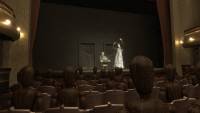 The Cloud Theatre project proposes to create realistic auralizations for applications in historic research in the field of the performing arts. The French project ANR-ECHO studies the use of voice in the recent history of theater. It is a multi-disciplinary project which combines the efforts of historians, theater scientists, and acousticians. In the scope of this project an audio-visual simulation was created which combines auralizations with visualizations of former configurations of the Théâtre de l'Athénée over a series of renovations, enabling researchers to realistically perceive theater performances in foregone rooms. Simulations include the room, 2 actors on stage, and an audience. To achieve these simulation, architectural plans were studied from archives providing various details of the different theater configurations, from which the corresponding visual and room acoustic geometrical acoustics (GA) models were created. The resulting simulations allow for 360° audio-visual presentations at various positions in the theater using commercial standard hardware.
The Cloud Theatre project proposes to create realistic auralizations for applications in historic research in the field of the performing arts. The French project ANR-ECHO studies the use of voice in the recent history of theater. It is a multi-disciplinary project which combines the efforts of historians, theater scientists, and acousticians. In the scope of this project an audio-visual simulation was created which combines auralizations with visualizations of former configurations of the Théâtre de l'Athénée over a series of renovations, enabling researchers to realistically perceive theater performances in foregone rooms. Simulations include the room, 2 actors on stage, and an audience. To achieve these simulation, architectural plans were studied from archives providing various details of the different theater configurations, from which the corresponding visual and room acoustic geometrical acoustics (GA) models were created. The resulting simulations allow for 360° audio-visual presentations at various positions in the theater using commercial standard hardware.
ECHO Project
 ECHO is a collaborative research project. Partners in the project include researchers from a wide range of disciplines : theatre professionals trained in history, anthropology, architecture, literature, music and aesthetics, researchers in sociology and philosophy, curators specialized in theatre and audiovisual, sound engineers and acousticians specializing in room acoustic simulations. ECHO is a French ANR-funded project (ANR-13-CULT-0004), 12/2013–06/2017.
ECHO is a collaborative research project. Partners in the project include researchers from a wide range of disciplines : theatre professionals trained in history, anthropology, architecture, literature, music and aesthetics, researchers in sociology and philosophy, curators specialized in theatre and audiovisual, sound engineers and acousticians specializing in room acoustic simulations. ECHO is a French ANR-funded project (ANR-13-CULT-0004), 12/2013–06/2017.
- THALIM-CNRS, équipe ARIAS (Atelier de recherche sur l'intermédialité et les arts du spectacle)
- LIMSI-CNRS, groupe Audio & Acoustique (now part of LAM, d'Alembert, Sorbonne University).
- Universiteit van Amsterdam, Theaterwetenschap (UvA) et Faculteit der Geesteswetenschappen, Capaciteitsgroep Media & Cultuur (UvA)
ECHO was born out of the idea that the study of Western theatre, despite its vocal, sound, and acoustic aspects, was no exception to the overvaluation of the visual. The research prolonged an initial project titled “Theatre Sound (19th - 21st centuries)” with a refocusing on three aspects: on France, on the second half of the 20th century, and on the spoken voice. The ECHO project approached theatre as a space organised by and for the spoken voice, thus returning to the commonly accepted definition by modern acousticians of the theatrical space (end of the 19th - beginning of the 20th), which seemed to be less suitable: technologies (from microphones to tape recorders) had transformed the sound of the theatre; significantly, the relation to the text, to the verbal, to the language (here, the French language) had experienced major transformations. Based on the hypothesis that, in the vital domain of language, transformation does not denote disappearance, the team explored how artists and technicians, from post-World War II to the end of the 1990s, have renewed the conditions and forms of the stage spoken word and its listening. In doing so, ECHO has allowed the reintegration of the theatre, an art which has contributed to structure Western society, within today’s crucial reflections on our relationship to the art of practicing (listening, reading, memorising, vocalising – singing) a written or elaborated language.
The ECHO project was the principal support through which the Ghost Orchestra and Cloud Theatre projects were carried.
Additional information is available here : ECHO project.
Fogg Art Museum
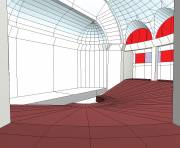
 The Fogg Art Museum reconstruction was one of our first efforts in virtual historic reconstruction.
The Fogg Art Museum reconstruction was one of our first efforts in virtual historic reconstruction.
At the end of the 19th century, an assistant professor of physics at Harvard University named Wallace Clement Sabine undertook the task of correcting the acoustics of the Fogg Art Museum Lecture Hall. Rather than merely correcting the acoustics, Sabine’s work on this acoustically difficult space (semi-circular, domed, with arched perimeter) formed the basis for his monumental research on reverberation time and absorption. This work and its subsequent publication established Room Acoustics as a real science, rather than guesswork and luck. During the next 70 years the room underwent several large renovations, and was demolished to make space for student housing in 1973. Learning of the impending demolition, one of the authors was fortunately able to access the room, making several room impulse response measurements the day prior to its final destruction. A computational room acoustics model has been created using architectural plans and the few available photographs. The historically important impulse response measurements of the room provide a reference calibration for the model. The geometrical model includes the various architectural phases of the room during its lifetime. Through simulation and auralization these versions of the room are restored in acoustical terms, allowing one to “experience” an educated rendering of the original acoustics as Sabine found it in 1895. The results of this study, in particular the geometrical model, have are available for public use, to allow future room acoustics students and researchers the opportunity to aurally follow in Sabine’s footsteps.
The EVAA platform
A platform for experimental virtual archeological-acoustics to study the influence of performance space (2019)
This starter grant from the Collegium Musicae Institute to the Institut Jean Le Rond ∂’Alembert financed the development of a real-time convolution engine support dynamic source orientation to promote research on the influence of room acoustics on the performance of musicians. The developed engine, in the form of a VST audio plug-in supporting source and receiver support in 3rd order HOA, was presented as a paper at the ISRA 2019 conference.
Influence on 17/18th century instrument playing techniques at Versailles
 EVAA_Ver : Multimodal study of the influence of rooms on playing techniques of musicians on 17th and 18th century instruments at Versailles (2019-2022)
EVAA_Ver : Multimodal study of the influence of rooms on playing techniques of musicians on 17th and 18th century instruments at Versailles (2019-2022)
A doctoral thesis grant by the Fondation des Sciences du Patrimoine (FSP) brings together researchers from several institutions : Université de Cergy-Pointoise, Centre de Recherche du Chateau de Versailles, and the Institut Jean Le Rond d'Alembert, Sorbonne Université, Paris
The PhD project consists of assisting in the creation of a real-time room acoustic simulator for use with musicians, taking into account the musicians movements and the impact of dynamic source directivity. The simulator will be put into use for studying the impact of room acoustics on musicians playing, focusing on comparisons between Baroque chamber music venues and classical period equivalents (Berlioz time). The thesis work will contribute to the research and documentation of pertinent venues, acoustic measurements of existing venues, and the creation of ecologically valid geometrical acoustics models of some of these venues. The thesis will include a series of perceptual studies examining the impact of acoustic variations on playing, in the context of historically informed performance methods.
- Here is a end-of-year student project from “Heritage, visualization and 3D modeling”, Cergy Paris University, showing the first graphic model and integration of an acoustic model rendering. Reconstruction project of the "Salon de Nobles", Chateau de Versailles (Video), project Licences Pro - Métiers du Numérique, 2020.
Reconstruction of the organ and chapel of the Sorbonne
 Digital reconstruction of the organ and chapel of the Sorbonne (2019-2022)
Digital reconstruction of the organ and chapel of the Sorbonne (2019-2022)
A doctoral thesis grant by the Institute of Computing and Data Sciences (ISCD) brings together researchers from the Musical Instrument in Interaction and Sound Spaces working groups within Lutheries - Acoustique - Musique (LAM), Institut Jean Le Rond ∂’Alembert.
The PhD project consists of the virtual reconstruction of the organ and the acoustics of the chapel, based on available documentation. The goal is a numerical simulation of the acoustic functioning of the pipes of the organ, the radiation of these pipes in the buffet, and the acoustic radiation of the buffet into the church. While most of the modeling components of these elements are known and described by acoustic theories, the modeling and simulation of the whole represents a major scientific challenge: over a thousand pipes (1365 to be precise) represent an ensemble of non-linear acoustic oscillators that radiate in a subspace (the buffet), itself coupled to the acoustic volume of the chapel. Such a numerical simulation of the instrument, based on documented construction details, should provide a means to listen to the virtual instrument from different positions in the chapel: organ stand, choir, nave… This simulation will bring to the foreground one of the historic treasures of the university and the city of Paris, prior to the scheduling of any restoration efforts.
PHÉnix : The Past Has Ears
 PHE : The Past Has Ears (2020-2023)
PHE : The Past Has Ears (2020-2023)
PHE is a collaborative research project. Partners in the project include researchers from a wide range of disciplines focusing on room acoustics as an important aspect of cultural heritage. Funding has been provided by the EU JPI Cultural Heritage project PHE.
- University of York, York, UK
- University of Parma, Parma, Italy
- Sorbonne Université, Paris, France
- Maison des Sciences de l’Homme (MSH) Lyon St-Etienne, Lyon, France
- Direction régionale des affaires culturelles d'Île-de-France (Notre Dame), Paris, France
- Houses of Parliament, London, UK
- Parco Archeologico di Tindari (Tindari Theatre), Tindari, Italy
When we think about great architectural achievements in European history, such as ancient amphitheatres or gothic cathedrals, their importance is strongly tied to their acoustic environment. The acoustics of a site is an intangible consequence of the space’s tangible construction and furnishings. It is ephemeral, while also a concrete result of the physical nature of the environment. Through the “Past Has Ears” project (the PHE project), we will explore how via measurements, research, and virtual reconstructions the acoustics of heritage spaces can be documented, reconstructed, and experienced for spaces both existing and in various altered states. Inspired by the project’s namesake (Phé, for the constellation Phoenix), and the recent fires at Notre Dame Cathedral in Paris (2019) and Teatro La Fenice opera hall (1996, also meaning Phoenix), PHE focuses on the preservation, conservation, and reconstruction of heritage sites, bringing them back from the ashes for use by researchers, stake holders, cultural institutions, and the general public. Comprising research teams with experience in acoustic reconstructions and historical research, paired with national heritage monuments of acoustic importance, the consortium will develop a joint methodology for addressing relevant archaeological acoustics issues across Europe with historians of different disciplines. Specialists in tangible/intangible cultural heritage legal issues ensure the viability and longevity of the methodology guidelines. The consortium will prototype next generation exploration tools for presenting digital acoustic reconstructions to scientists and museum visitors alike. Results will be evaluated with associated test heritage sites, created in partnership with stakeholders and experienced content producers. Presentation methods provide first-person in-situ or offsite explorations, with the ability to experience various historical periods. For deteriorated sites, this approach provides access to situations impossible to experience onsite.
Visit the PHE project site for more information.
PHEND : The Past Has Ears at Notre Dame
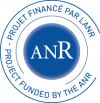 PHEND : The Past Has Ears at Notre Dame (2020-2024)
PHEND : The Past Has Ears at Notre Dame (2020-2024)
PHEND is a French collaborative research project funded by the ANR. Partners in the project include researchers from a wide range of disciplines, all with an interest in the sonic history of the Notre-Dame cathedral.
- Institut Jean Le Rond d'Alembert, Sorbonne Université, Paris
- Centre André Chastel (CAC) : Laboratoire de recherche en histoire de l'art, Sorbonne Université, Paris
- Institut de recherche en Musicologie (IReMus) , Sorbonne Université, Paris
- Maison des Sciences de l’Homme (MSH) Lyon St-Etienne, Lyon
- Conservatoire National Supérieur de Musique et de Danse de Paris (CNSMDP), SACRe (Sciences, arts, création, recherche), Paris
- Sunmetron, Agence d'architecture présentant des compétences en création, réhabilitation et restauration d'édifices, Paris
- Narrative, Producteur pour les nouveaux médias, Paris
When we think about great architectural achievements in history, such as Gothic cathedrals, their importance is strongly tied to their acoustic environment. The acoustics of a heritage site is an intangible consequence of the space’s tangible construction and furnishings. It is ephemeral, while also a concrete result of the physical nature of the environment. Through this project, we will explore how via measurements, research, and virtual reconstructions the acoustics of one of France’s most notable heritage spaces can be documented, reconstructed, and experienced by both researchers and the general public. Inspired by the project’s namesake (Phé, for the constellation Phoenix), the project focuses on the digital reconstruction of Notre-Dame de Paris, a world heritage site, bringing it back from the ashes, examining its evolution and importance in history, and working with the restoration team on its future. The consortium comprises research teams in SHS and STIC, with experience in historical, musical, architectural, and acoustical research.
- Presentation of some preliminary results presented at the I3DA conference in 2021 : “Virtual Notre-Dame: Preliminary results of real-time auralization with choir members” (preprint)
Visit the PHEND project site for more information.
I.M.A.P.I.
 The I.M.A.P.I project (Interprétation Musicale en Acoustique Patrimoniale Immersive) is part of the archaeo-acoustic framework and consists of an attempt to recreate the historical ambiances of a major heritage site for music in the Mediterranean region: the Pontifical Chapel of the Palace of the Popes in Avignon. This building, which was one of the major centers of polyphony in the 14th century, is still today one of the most suitable places in the region for the interpretation of medieval vocal music as instrumental music. The aim is to question the listening of 14th century heritage music through a corpus of polyphonic works, interpreted via an immersive virtual acoustic environment reproducing the papal chapel around 1362. This reconstruction will enable exploring new avenues of research into historically informed musical practices and the interaction between the musical gesture and sound space with which it resonates.
The I.M.A.P.I project (Interprétation Musicale en Acoustique Patrimoniale Immersive) is part of the archaeo-acoustic framework and consists of an attempt to recreate the historical ambiances of a major heritage site for music in the Mediterranean region: the Pontifical Chapel of the Palace of the Popes in Avignon. This building, which was one of the major centers of polyphony in the 14th century, is still today one of the most suitable places in the region for the interpretation of medieval vocal music as instrumental music. The aim is to question the listening of 14th century heritage music through a corpus of polyphonic works, interpreted via an immersive virtual acoustic environment reproducing the papal chapel around 1362. This reconstruction will enable exploring new avenues of research into historically informed musical practices and the interaction between the musical gesture and sound space with which it resonates.
This is an interdisciplinary Arts-Sciences research program, implementing cross-links between artistic practices, heritage musical interpretation, and acoustics.
- PRISM Laboratory, Aix-Marseille Université, Marseille (project leader)
- Avignon Tourisme and the Avignon City Council
- Diabolus in Musica music ensemble
- Institut Jean Le Rond d'Alembert, Sorbonne Université, Paris
HeSoAN
 The HeSoAN (Hear the Sound of Ars Nova) project aims to conduct experimental research on the interpretation of Ars Nova music, as it was sung in the papal chapel of Avignon in the 14th century. Led by Julien Ferrando, this research is carried out within an experimental framework in archaeoacoustics, relying on a 3D architectural survey that accurately reconstructs the ceremonial space of the papal chapel as it resonated around 1362. The project will allow for a detailed investigation into the auditory experience of musicians (performances within the reconstructed medieval context) as well as the heritage dimension (the reception of the works in the medieval acoustics). It will also examine the reception of polytextual musical works (motets and mass movements), furthering our understanding of the effects of compositional techniques and the subtle interactions between text and music as conveyed to various audiences. The HeSoAN project will offer a new way of understanding the musical and sonic history of this significant medieval monument.
The HeSoAN (Hear the Sound of Ars Nova) project aims to conduct experimental research on the interpretation of Ars Nova music, as it was sung in the papal chapel of Avignon in the 14th century. Led by Julien Ferrando, this research is carried out within an experimental framework in archaeoacoustics, relying on a 3D architectural survey that accurately reconstructs the ceremonial space of the papal chapel as it resonated around 1362. The project will allow for a detailed investigation into the auditory experience of musicians (performances within the reconstructed medieval context) as well as the heritage dimension (the reception of the works in the medieval acoustics). It will also examine the reception of polytextual musical works (motets and mass movements), furthering our understanding of the effects of compositional techniques and the subtle interactions between text and music as conveyed to various audiences. The HeSoAN project will offer a new way of understanding the musical and sonic history of this significant medieval monument.
In 2024-2025, a series of experiments will be conducted with the LAM team (IJLRDA, SU), the IDEAS laboratory (CNRS / Aix-Marseille University), the Musica Nova ensemble (Lucien Kandel), and the Diabolus in Musica ensemble (Nicolas Sansarlat). This innovative experimental setup will open up new avenues of research into the musical gestures that emerge from these experiments.
Through a selected corpus of monodic and polyphonic productions linked to the papal chapel, this experimentation will facilitate:
- Archaeoacoustic studies concerning the placement of singers within the ceremonial space of the 14th century.
- Proposition of an immersive museum journey into the musical history of the Palais des Papes in the 14th century.
Preliminary results of the experiments and analysis of performers' testimonies will be presented through a series of filmed interviews and post-experimentation surveys. This project falls within the realm of practice-based research, with collaborations between scientists & scholars (musicologists, acousticians, aestheticians) and artists. The experimental immersive heritage acoustics recordings will contribute to the future immersive visitor experience of the Palais des Papes.
AEEHmusic
 The AEEHmusic project (Archaeological-Acoustic Exploration of a Liturgical Chant Model (Hildegard of Bingen) in the Context of Early European Music of the First Millennium) is a collaboration led by Géraldine Gaudefroy-Demombynes, Associate Professor in Musicology at the Université Rennes 2.
The AEEHmusic project (Archaeological-Acoustic Exploration of a Liturgical Chant Model (Hildegard of Bingen) in the Context of Early European Music of the First Millennium) is a collaboration led by Géraldine Gaudefroy-Demombynes, Associate Professor in Musicology at the Université Rennes 2.
The aim of this project is to revive nine sacred female monodic a capella songs in Latin by Hildegard of Bingen, taken from her Symphonie des Harmonies et révélations célestes, using a multidisciplinary approach supported by a team of specialists in the relationship between the written word and sound, vocal expression and acoustics. The aim is threefold: a historically informed reconstruction, an acoustic analysis of Hildegard's chants in the acoustics closest to Benedictine abbeys, and a professional audio-visual recording of the liturgical corpus thus formed, the Vespers for Mary - by 12 singers from the Ensemble Organum (dir. Marcel Pérès). The humanities component is based on musical archaeology (musical manuscripts), Marian worship, Rhenish liturgical aesthetics and religious architecture. The acoustic sciences are using special software to analyse the phonatory and frequency signatures of the chants. A second corpus of monodies, four gwerzioù (a capella and in Breton on themes relating to the sacred), will be produced in the same ecological conditions as Hildegarde's songs, by the same singers, and the MAX PLANCK Institute will initiate the first auditory cognition study on these two corpora. The multidisciplinary approach should make it possible to specify the musical and acoustic specificities of each of the two corpora.
Further branches of the umbrella HVBingenproject© will address other aspects or perspectives around the works of Hildegard of Bingen.
Contact
Inquiries regarding EVAA should be addressed to brian.katz@sorbonne-universite.fr
